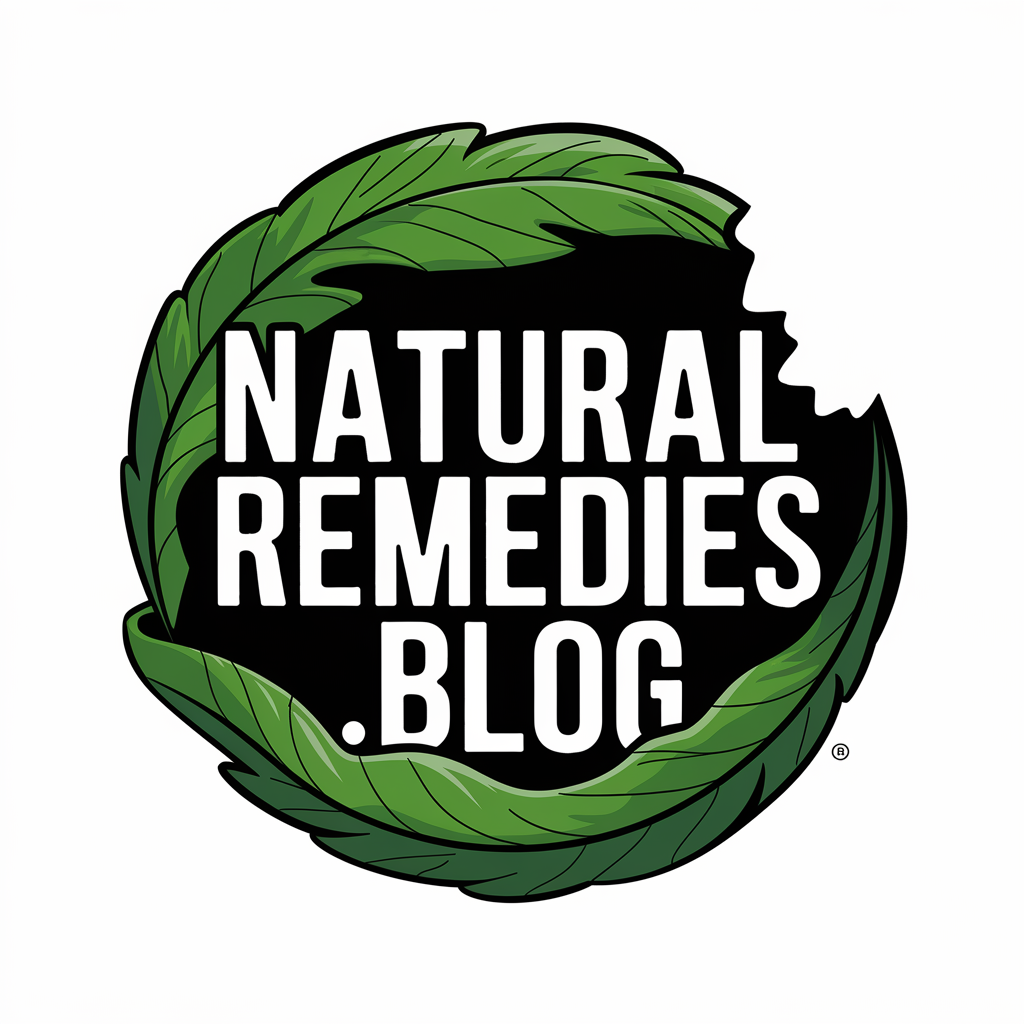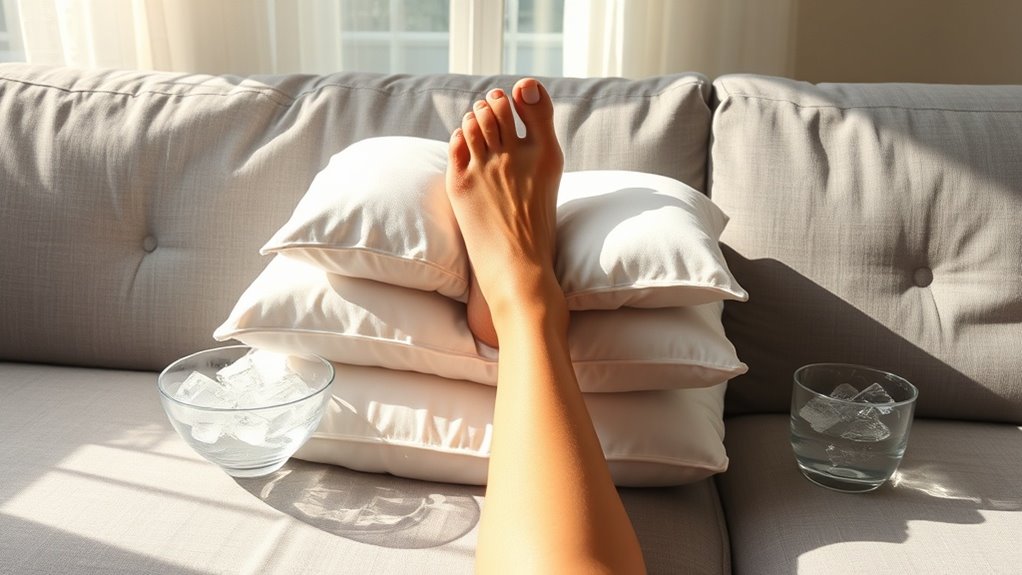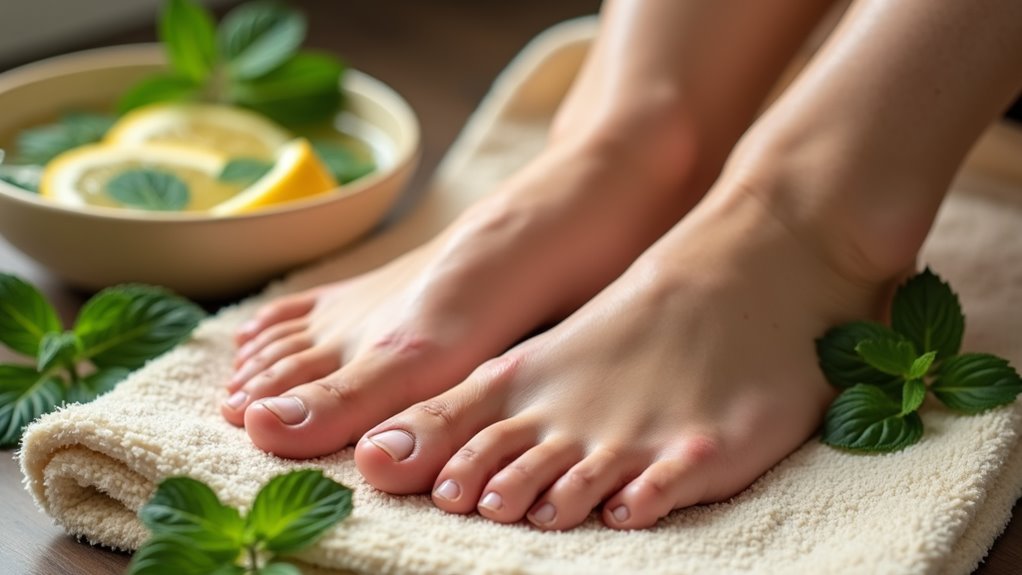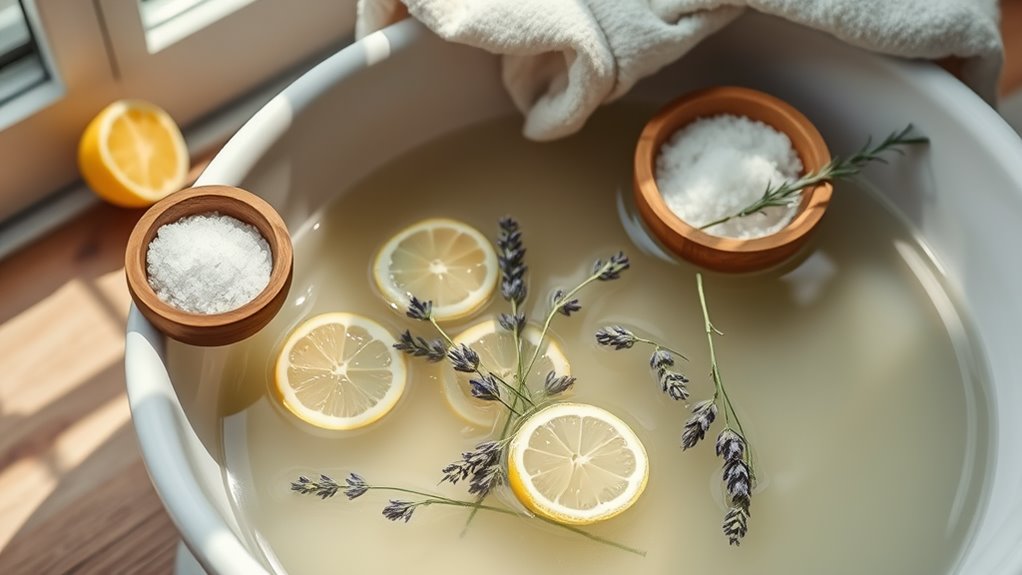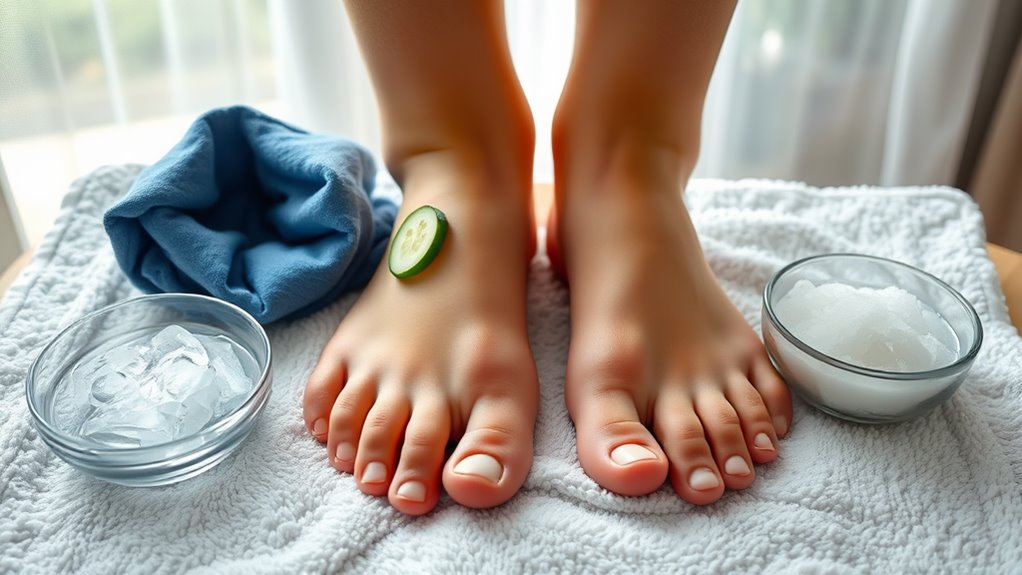Swollen Feet Relief Trick I Use After Long Days
Understanding Swollen Feet: Causes and Symptoms
When your feet begin to swell, it’s essential to identify the underlying cause before seeking treatment. Common triggers include prolonged standing, excessive salt intake, pregnancy, or underlying medical conditions like heart disease, kidney problems, or circulation issues.
You’ll notice symptoms like tight skin, shiny appearance, and difficulty fitting into shoes. Your feet may feel heavy, and you might experience discomfort when walking. Understanding the role of poor circulation in contributing to swelling can help inform your approach to treatment.
While various swollen feet remedies exist, understanding whether your swelling is temporary or a sign of a serious condition will determine the most effective treatment approach.
Watch for accompanying symptoms like chest pain or shortness of breath.
My Personal Experience With Foot Swelling
You’ll likely notice that reducing foot swelling doesn’t happen instantly, as the process requires consistent treatment and monitoring over time. If your swelling persists or worsens despite initial interventions, it’s critical to document any changes in appearance, pain levels, or mobility limitations. Your healthcare provider should evaluate any significant increase in swelling, especially if it’s accompanied by redness, warmth, or acute pain. Additionally, being aware of common causes of edema can help you identify potential underlying issues contributing to your foot swelling.
Finding Relief Takes Time
After experiencing severe foot swelling myself, I learned that finding lasting relief requires patience and consistent treatment.
You’ll need to understand that edema reduction doesn’t happen instantly, even with proper interventions.
Key timing factors to consider:
- Initial relief may take 30-60 minutes of elevation
- Consistent treatment for 3-5 days often needed for significant improvement
- Chronic cases may require 2-3 weeks of dedicated management
Monitor your progress carefully, documenting changes in swelling levels throughout the day.
If symptoms persist beyond two weeks of diligent treatment, consult your healthcare provider for further evaluation.
When Swelling Gets Worse
Despite following proper treatment protocols, some patients experience worsening foot swelling that requires immediate medical attention.
If you notice sudden, severe swelling accompanied by warmth, redness, or pain in one or both feet, don’t wait to seek help. These symptoms could indicate deep vein thrombosis or infection.
Other red flags include difficulty breathing, chest pain, or fever along with the swelling.
If you’ve got diabetes, heart disease, or kidney problems, you’re at higher risk for complications.
Watch for skin that stays dimpled after pressing it, unusual discoloration, or blisters forming on your feet.
The Science Behind Foot Swelling
Your feet swell when fluid accumulates in the tissues due to compromised blood circulation, gravity’s effects, or systemic inflammation.
Blood flow problems can stem from venous insufficiency, where your veins struggle to pump blood back up from your feet to your heart efficiently.
Inflammation triggers fluid retention in your feet’s soft tissues as your immune system responds to injury, infection, or underlying medical conditions. Additionally, serious causes like heart, liver, or kidney conditions may also contribute to fluid imbalance and swelling.
Why Feet Swell Up
Foot swelling occurs when excess fluid accumulates in the tissues of your feet through a process called edema.
Your body’s circulation system can’t efficiently move blood and fluid back up against gravity, causing pooling in your lower extremities.
Common triggers that lead to swollen feet include:
- Extended periods of sitting or standing that reduce muscle pump action
- High sodium intake causing fluid retention
- Medical conditions affecting circulation or lymphatic drainage
You’ll notice this swelling more prominently in hot weather, during pregnancy, or if you’ve consumed excessive salt.
Blood vessels dilate in response to heat, making fluid accumulation more likely.
Blood Flow Affects Swelling
When blood flow in your lower extremities becomes compromised, it directly impacts the natural fluid balance in your feet and ankles.
Your circulatory system’s ability to pump blood back to your heart weakens, causing fluid retention in the surrounding tissues.
Gravity compounds this effect when you’re standing or sitting for extended periods.
Your blood vessels dilate to accommodate increased blood volume, but inefficient circulation prevents proper fluid drainage.
This leads to edema, where excess fluid accumulates in the interstitial spaces between cells.
The result is visible swelling, accompanied by discomfort and a sensation of heaviness in your feet.
Inflammation’s Role in Swelling
Inflammation plays a central role in foot swelling through complex biochemical processes.
When your feet experience stress or injury, your immune system triggers an inflammatory response, causing blood vessels to dilate and become more permeable.
Your body’s inflammatory reaction leads to:
- Release of prostaglandins that increase blood flow
- Migration of white blood cells to affected areas
- Accumulation of fluid in surrounding tissues
This natural defense mechanism, while protective, can result in uncomfortable swelling.
Understanding inflammation’s role helps explain why anti-inflammatory measures, like ice therapy and certain medications, effectively reduce foot swelling and associated discomfort.
Essential Materials for This Relief Method
Before beginning this therapeutic intervention for swollen feet, you’ll need to gather several essential materials.
You’ll require a large basin or foot bath container deep enough to submerge your feet to ankle level, Epsom salt (magnesium sulfate), cold water, ice cubes, a clean towel, and a timer. For enhanced results, collect compression socks rated 15-20 mmHg, an elevated cushion or pillow, and anti-inflammatory cream containing menthol or arnica. Additionally, incorporating natural home remedies like alternating hot and cold water soaks can further improve circulation and reduce inflammation. If you’re incorporating stretching exercises, you’ll also need a flat, non-slip surface and a resistance band for targeted foot flexibility work.
Step-by-Step Guide to My Relief Technique
To effectively reduce foot swelling, follow this systematic relief protocol designed to improve circulation and reduce fluid retention.
Begin by elevating your feet above heart level using firm pillows. While elevated, perform gentle ankle rotations to activate the calf muscle pump mechanism.
- Apply firm compression socks, starting from toes and moving upward.
- Massage feet using circular motions for 5 minutes per foot.
- Submerge feet alternately in warm (2 minutes) and cool (30 seconds) water for 3 cycles.
Complete the protocol with light walking to stimulate blood flow and lymphatic drainage. Remember that staying hydrated is essential throughout the process.
Additional Tips to Enhance Recovery
While the systematic relief protocol forms the foundation of swelling reduction, several complementary practices can accelerate your recovery and prevent future episodes. You’ll need to integrate these evidence-based interventions alongside your primary treatment.
| Practice | Duration | Benefit |
|---|---|---|
| Compression Socks | 8-12 hours daily | Promotes circulation |
| Dietary Sodium Limit | Under 2300mg/day | Reduces fluid retention |
| Leg Elevation | 20 min, 3x daily | Enhances lymphatic drainage |
| Hydration | 2-3L water daily | Prevents fluid stagnation |
| Walking Breaks | 5 min every hour | Activates muscle pump |
Monitor your symptoms and adjust these interventions based on your body’s response.
When to Seek Medical Attention
Although most cases of swollen feet can be managed with self-care measures, certain warning signs demand immediate medical evaluation.
If you experience severe, sudden, or unexplained swelling, especially if it’s one-sided, contact your healthcare provider immediately.
Seek emergency care if you notice:
- Chest pain, shortness of breath, or difficulty breathing along with the swelling
- Warmth, redness, or tenderness in your calf accompanied by swelling
- Swelling with fever, skin that’s hot to touch, or discoloration spreading up your leg
These symptoms could indicate serious conditions like blood clots, heart failure, or infection requiring prompt medical intervention.
Prevention Strategies for Daily Life
Since preventing foot swelling is easier than treating it, incorporating specific lifestyle changes can significantly reduce your risk of edema. You’ll need to focus on circulation-promoting activities and proper foot care throughout your day.
| Activity | Duration | Benefit |
|---|---|---|
| Walking | 30 min/day | Improves circulation |
| Leg raises | 5 min/4x day | Reduces fluid buildup |
| Compression socks | During activity | Prevents venous pooling |
| Foot flexes | 2 min/hour | Activates calf pump |
| Water intake | 8-10 glasses | Prevents fluid retention |
Remember to maintain a low-sodium diet, avoid prolonged sitting, and elevate your feet whenever possible. Keep moving regularly, even if you’re desk-bound at work.
Long-Term Benefits of Regular Foot Care
Maintaining consistent foot care routines will yield significant health benefits that extend far beyond basic comfort.
Regular attention to your feet’s health can prevent chronic conditions and enhance your overall mobility throughout life.
Key long-term advantages include:
- Improved circulation and nerve function, reducing risks of peripheral neuropathy
- Enhanced joint flexibility and reduced arthritic symptoms in ankles and toes
- Prevention of structural deformities like bunions and hammertoes
Through proactive maintenance, you’ll significantly decrease your likelihood of requiring surgical interventions or experiencing mobility limitations in later years.
This investment in foot health directly correlates with maintaining independence and quality of life.
